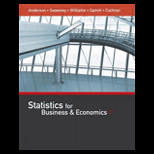
Concept explainers
Queen City
Cincinnati, Ohio, also known as the Queen City, has a population of approximately 298.000 and is the third largest city in the state of Ohio. The Cincinnati metropolitan area has a population of about 2.2 million. The city is governed by a mayor and a nine-member city council. The city manager, who is responsible for the day-to-day operation of the city, reports to the mayor and city council. The city manager recently created the Office of Performance and Data Analytics with the goal of improving the efficiency of city operations.
TABLE 2.21 ANNUAL EXPENDITURES FOR QUEEN CITY (FIRST FOUR ENTRIES)

One of the first tasks of this new office is to review the previous year’s expenditures. The file QueenCity contains data on the previous year’s expenditures, including the following:
Department The number of the department incurring the expenditure
Department Description The name of the department incurring the description
Category The category of the expenditure
Fund The fund to which the expenditure was charged
Expenditure The dollar amount of the expense
Table 2.21 shows the first four entries of the 5427 expenditures for the year. The city manager would like to use this data to better understand how the city’s budget is being spent.
Managerial Report
Use tabular and graphical methods of
- 1. Tables and/or graphical displays that show the amount of expenditures by category and percentage of total expenditures by category.
- 2. A table that shows the amount of expenditures by department and the percentage of total expenditures by department. Combine any department with less than 1% into a category named “Other.”
- 3. A table that shows the amount of expenditures by fund and the percentage of total expenditures by fund. Combine any fund with less than 1 % into a category named “Other.”
1.
Make tabular and graphical displays that show the amount of expenditure by category and percentage of total expenditures by category.
Answer to Problem 3CP
The table represents the total amount of expenditure by category and percentage of total expenditures by category.
| Category | Total Expenditure | Percentage of total Expenditure |
| Capital | $198,365,854 | 29.98% |
| Payroll | $145,017,555 | 21.92% |
| Debt service | $86,913,978 | 13.14% |
| Contractual services | $85,043,249 | 12.85% |
| Fringe benefits | $66,053,340 | 9.98% |
| Fixed costs | $53,732,177 | 8.12% |
| Materials and supplies | $19,934,710 | 3.01% |
| Inventory | $6,393,394 | 0.97% |
| Payables | $180,435 | 0.03% |
| Grand Total | $661,634,693 | 100.0% |
The bar chart for “Category” is given below:
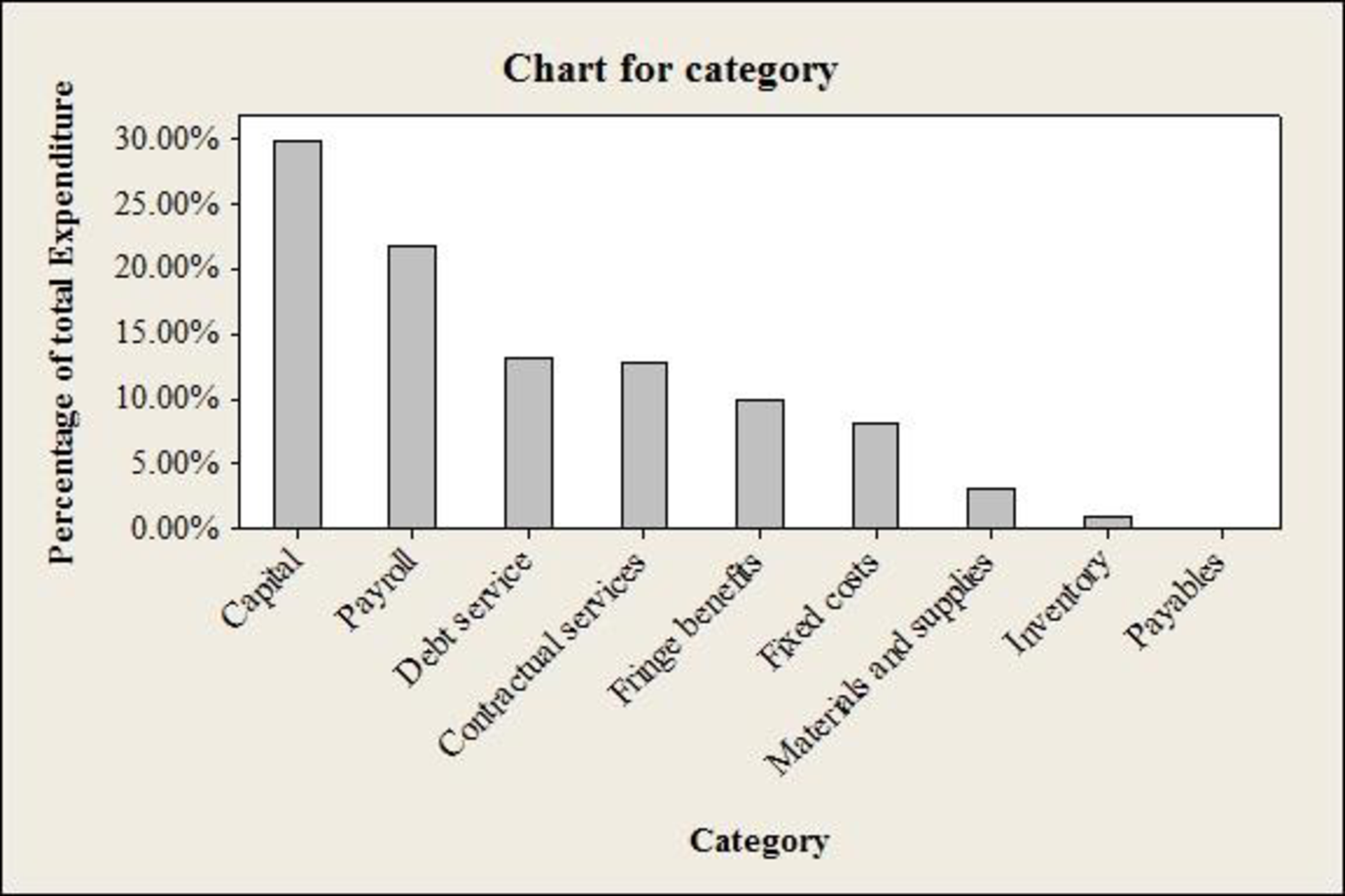
Explanation of Solution
Calculation:
The table represents the sample of 5,427 entries annual expenditures for queen city (Cincinnati, Ohio) for the year. The five types of variables present in the data are department serial number, department description, category name, fund and expenditure.
From the data set, the variable “Category” consists of nine entities namely capital, payroll, debt service, contractual services, fringe benefits, fixed costs, Materials and supplies, inventory and payable.
Therefore, the following table shows the amount of all nine entities total expenditure by category.
| Category | Total Expenditure |
| Capital | $198,365,854 |
| Payroll | $145,017,555 |
| Debt service | $86,913,978 |
| Contractual services | $85,043,249 |
| Fringe benefits | $66,053,340 |
| Fixed costs | $53,732,177 |
| Materials and supplies | $19,934,710 |
| Inventory | $6,393,394 |
| Payables | $180,435 |
| Grand Total | $661,634,693 |
The percentage for capital is calculated as the ratio of total expenditure for capital to the grand totals of all categories.
The following table shows the percentage of amount of all nine entities total expenditure by category:
| Category | Total Expenditure | Percentage of total Expenditure |
| Capital | $198,365,854 | 29.98% |
| Payroll | $145,017,555 | 21.92% |
| Debt service | $86,913,978 | 13.14% |
| Contractual services | $85,043,249 | 12.85% |
| Fringe benefits | $66,053,340 | 9.98% |
| Fixed costs | $53,732,177 | 8.12% |
| Materials and supplies | $19,934,710 | 3.01% |
| Inventory | $6,393,394 | 0.97% |
| Payables | $180,435 | 0.03% |
| Grand Total | $661,634,693 | 100.0% |
Software procedure:
Step-by-step software procedure to obtain bar chart for category using MINITAB software is as follows:
- From Bars represent, choose Values from a table.
- UnderOne column of values, choose Simple. Click OK.
- Choose Simple, and then click OK.
- In Graph variables, enter the column of percent frequency for total expenditure.
- In Categorical variables, enter the column of entities of category.
- Click OK.
Output using the MINITAB software is given below:

From the obtained table and bar chart, it is observed that the Capital expenditures and payroll account for over 50% of all expenditures.
Also, the total expenditures are over $660 million. Debt Service seems to be high, and it is found to be over 10% of total expenditures.
2.
Make tabular displays that show the amount of expenditure by department and percentage of total expenditures by department.
Answer to Problem 3CP
The table represents the total amount of expenditure by department and percentage of total expenditures by department.
| Department Description | Percentage of total Expenditure | Total Expenditure |
| Department of Police | 9.72% | 64,295,941 |
| Department of Sewers | 8.76% | 57,954,955 |
| Transportation and Engineering, Engineering | 8.72% | 57,686,199 |
| Department of Fire | 7.23% | 47,838,396 |
| Sewers, Debt Service | 6.59% | 43,585,814 |
| Finance, Risk Management | 5.39% | 35,654,238 |
| SORTA Operations | 3.62% | 23,975,000 |
| Water Works, Debt Service | 3.24% | 21,418,102 |
| Department of Water Works | 3.07% | 20,307,505 |
| Finance, Treasury | 2.80% | 18,531,650 |
| Economic Development | 2.13% | 14,078,735 |
| Division of Parking Facilities | 1.89% | 12,489,731 |
| Community Development, Housing | 1.75% | 11,556,943 |
| Enterprise Technology Solutions | 1.71% | 11,314,215 |
| Public Services, Fleet Services | 1.66% | 10,982,312 |
| Finance, Accounts & Audits | 1.66% | 10,960,345 |
| Transportation and Engineering, Planning | 1.63% | 10,764,138 |
| Public Services, Neighborhood Operations | 1.38% | 9,140,769 |
| Sewers, Millcreek | 1.30% | 8,575,226 |
| Health, Primary Health Care Centers | 1.25% | 8,268,632 |
| Water Works, Water Supply | 1.19% | 7,883,099 |
| Public Services, Facilities Management | 1.13% | 7,469,863 |
| Sewers, Wastewater Administration | 1.01% | 6,668,240 |
| Other department less than 1 percent each | 21.2% | 1,40,234,644 |
The bar chart for “Department description” is given below:
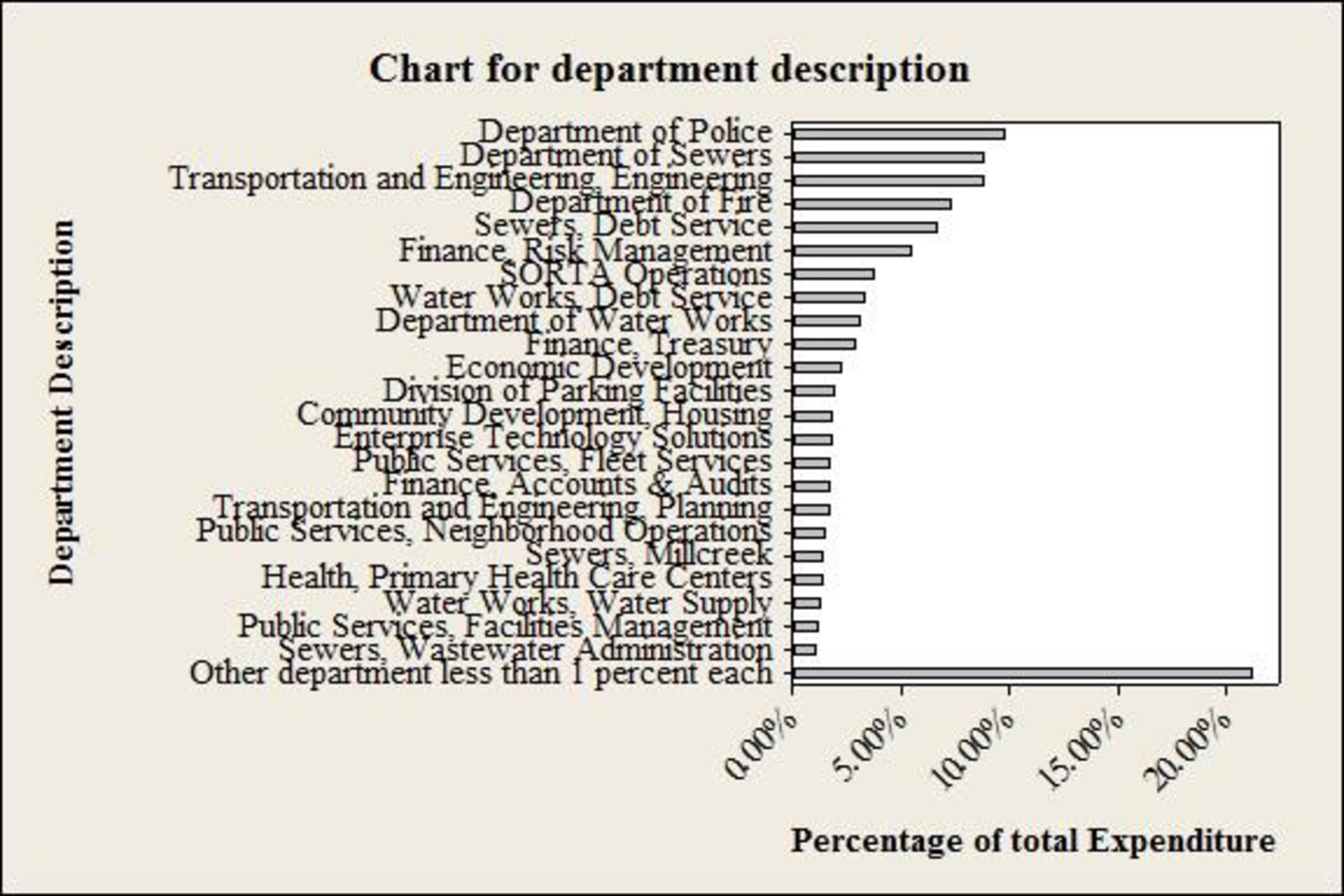
Explanation of Solution
Calculation:
Here, any departments with less than 1% are combined into a category named “other”.
Department descriptionwith less than 1% is tabulated as follows with named as “other”:
| Other (department description less than 1%) | Percentage of total Expenditure | Total Expenditure |
| Water Works, Distribution | 0.98% | 64,90,554 |
| Public Services, Traffic and Road Operations | 0.89% | 58,84,799 |
| Parks, Administrative and Program Services | 0.87% | 57,44,316 |
| Water Works, Commercial Services | 0.81% | 53,60,380 |
| Sewers, Wastewater Collection | 0.81% | 53,31,756 |
| Sewers, Director/Stormwater | 0.79% | 52,13,170 |
| Parks, Operations and Facility Mgmt | 0.76% | 50,08,200 |
| Police Emergency Communications | 0.69% | 45,57,589 |
| Division of Convention Center | 0.67% | 44,60,267 |
| Health, Primary Health Care Programs | 0.58% | 38,21,334 |
| Health, Community Health Services | 0.56% | 36,75,649 |
| Sewers, Maintenance | 0.55% | 36,68,040 |
| Water Works, Water Quality and Treatment | 0.51% | 33,95,988 |
| Recreation, Support Services | 0.50% | 33,15,938 |
| Law Department | 0.47% | 30,78,594 |
| Recreation, Golf | 0.42% | 27,81,652 |
| Water Works, Business Services | 0.41% | 26,93,873 |
| New Construction & Building Standards | 0.40% | 26,77,798 |
| Water Works, Engineering | 0.39% | 25,83,805 |
| Division of Traffic Engineering | 0.38% | 25,04,453 |
| Cincinnati Public School Reserve | 0.38% | 25,00,000 |
| Sewers, Little Miami | 0.37% | 24,39,869 |
| Planning, Licenses & Permits | 0.36% | 23,71,973 |
| Workers' Compensation Insuranced | 0.33% | 22,14,094 |
| Motorized and Construction Equipment | 0.33% | 21,87,298 |
| Recreation, Maintenance | 0.33% | 21,62,545 |
| General Fund Overhead | 0.32% | 20,95,756 |
| Health, Primary School &Adolesent | 0.31% | 20,74,254 |
| Community Development Administration | 0.30% | 19,68,773 |
| Sewers, Industrial Waste | 0.28% | 18,41,374 |
| Office of the City Manager | 0.26% | 17,12,437 |
| Sewers, Project Delivery | 0.25% | 16,82,688 |
| Finance, Purchasing | 0.24% | 16,00,148 |
| Recreation, Athletics | 0.24% | 15,82,290 |
| Office of Environmental Qualities | 0.23% | 15,48,437 |
| Recreation, West Region | 0.22% | 14,87,931 |
| Finance, Income Tax | 0.22% | 14,83,479 |
| Health, Commissioner | 0.21% | 14,18,825 |
| Recreation, Central Region | 0.21% | 13,93,663 |
| Recreation, East Region | 0.20% | 13,50,682 |
| Community Development | 0.20% | 13,37,001 |
| Sewers, Muddy Creek | 0.18% | 12,11,584 |
| Health, Technical Resources | 0.17% | 11,22,229 |
| Sewers, Planning | 0.17% | 10,92,095 |
| Enterprise Software and Licenses | 0.16% | 10,82,024 |
| Water Works, IT | 0.16% | 10,39,488 |
| Sewers, Wastewater Engineering | 0.15% | 9,73,882 |
| Department of Human Resources | 0.14% | 9,29,460 |
| Department Of Planning & Buildings | 0.14% | 9,11,988 |
| Office and Technical Equipment | 0.13% | 8,63,762 |
| Bond Fund - Principal and Interest | 0.12% | 7,74,523 |
| Sewers, Sycamore | 0.11% | 7,54,132 |
| Transportation and Engineering Director | 0.11% | 7,20,092 |
| Division of Aviation | 0.11% | 7,02,480 |
| Budget & Evaluation | 0.08% | 5,62,270 |
| Sewers, Polk Run | 0.08% | 5,32,890 |
| Sewers, Taylor Creek | 0.08% | 5,29,774 |
| Citizens' Complaint Authority | 0.07% | 4,31,449 |
| Sewers, Superintendent | 0.06% | 4,28,268 |
| Contribution to Fire Pension | 0.06% | 4,16,783 |
| Contribution to Police Pension | 0.06% | 4,00,439 |
| Public Services, Director | 0.06% | 3,97,815 |
| Port Authority Greater Cincinnati Development | 0.05% | 3,50,000 |
| City Council | 0.05% | 3,37,658 |
| Hamilton Co. Auditor & Treasurer Fees | 0.05% | 2,98,758 |
| Office of The Clerk of Council | 0.04% | 2,93,185 |
| Office of The Mayor | 0.04% | 2,87,622 |
| Lump Sum Payments | 0.04% | 2,52,054 |
| Finance Director’s Office | 0.03% | 2,13,548 |
| County Clerk Fees | 0.03% | 1,75,000 |
| Public Employees Assistance Program | 0.02% | 1,61,711 |
| Police and Fire Fighter's Insurance | 0.02% | 1,15,000 |
| Parks, Office of Director | 0.01% | 94,987 |
| Special Investigations/Studies | 0.01% | 92,210 |
| Councilmember PG Sittenfeld | 0.01% | 77,451 |
| Surplus | 0.01% | 76,091 |
| Councilmember Y. Simpson | 0.01% | 70,985 |
| Councilmember W. Young | 0.01% | 63,012 |
| Councilmember R. Qualls | 0.01% | 62,862 |
| Councilmember C. Seelbach | 0.01% | 60,177 |
| Councilmember Quinlivan | 0.01% | 57,685 |
| Councilmember C. Winburn | 0.01% | 57,654 |
| Downtown Special Inprovement District | 0.01% | 56,000 |
| Memberships & Publications | 0.01% | 53,150 |
| Cincinnati Music Hall | 0.01% | 50,000 |
| Election Expense | 0.01% | 46,580 |
| Convention Facility Authority | 0.01% | 45,700 |
| Councilmember C. Thomas | 0.01% | 45,603 |
| Councilmember C. Smitherman | 0.01% | 43,141 |
| Mayor's Office Obligations | 0.01% | 41,194 |
| State Unemployment Comp | 0.00% | 31,671 |
| Manager's Office Obligations | 0.00% | 13,956 |
| Councilmember P. Thomas | 0.00% | 13,168 |
| Judgments Against the City | 0.00% | 7,644 |
| Department of Public Recreation | 0.00% | 5,093 |
| Audit & Examiners Fees | 0.00% | 5,000 |
From the data set, the variable “department description” has 119 different departments out of which 96 departments whose percentage is less than 1.
Therefore, the following table shows the expenditure of all 119 different departments.
| Department Description | Total Expenditure |
| Department of Police | 64,295,941 |
| Department of Sewers | 57,954,955 |
| Transportation and Engineering, Engineering | 57,686,199 |
| Department of Fire | 47,838,396 |
| Sewers, Debt Service | 43,585,814 |
| Finance, Risk Management | 35,654,238 |
| SORTA Operations | 23,975,000 |
| Water Works, Debt Service | 21,418,102 |
| Department of Water Works | 20,307,505 |
| Finance, Treasury | 18,531,650 |
| Economic Development | 14,078,735 |
| Division of Parking Facilities | 12,489,731 |
| Community Development, Housing | 11,556,943 |
| Enterprise Technology Solutions | 11,314,215 |
| Public Services, Fleet Services | 10,982,312 |
| Finance, Accounts & Audits | 10,960,345 |
| Transportation and Engineering, Planning | 10,764,138 |
| Public Services, Neighborhood Operations | 9,140,769 |
| Sewers, Millcreek | 8,575,226 |
| Health, Primary Health Care Centers | 8,268,632 |
| Water Works, Water Supply | 7,883,099 |
| Public Services, Facilities Management | 7,469,863 |
| Sewers, Wastewater Administration | 6,668,240 |
| Other department less than 1 percent each | 140,234,644 |
| Grand Total | 661,634,692 |
The percentage for department description is calculated as the ratio of total expenditure to the grand totals all departments.
Therefore, the following table shows the percentage of amount of all department total expenditure by department.
| Department Description | Percentage of total Expenditure |
| Department of Police | 9.72% |
| Department of Sewers | 8.76% |
| Transportation and Engineering, Engineering | 8.72% |
| Department of Fire | 7.23% |
| Sewers, Debt Service | 6.59% |
| Finance, Risk Management | 5.39% |
| SORTA Operations | 3.62% |
| Water Works, Debt Service | 3.24% |
| Department of Water Works | 3.07% |
| Finance, Treasury | 2.80% |
| Economic Development | 2.13% |
| Division of Parking Facilities | 1.89% |
| Community Development, Housing | 1.75% |
| Enterprise Technology Solutions | 1.71% |
| Public Services, Fleet Services | 1.66% |
| Finance, Accounts & Audits | 1.66% |
| Transportation and Engineering, Planning | 1.63% |
| Public Services, Neighborhood Operations | 1.38% |
| Sewers, Millcreek | 1.30% |
| Health, Primary Health Care Centers | 1.25% |
| Water Works, Water Supply | 1.19% |
| Public Services, Facilities Management | 1.13% |
| Sewers, Wastewater Administration | 1.01% |
| Other department less than 1 percent each | 21.2% |
Software procedure:
Step-by-step software procedure to obtain bar chart for category using MINITAB software is as follows:
- From Bars represent, choose Values from a table.
- Under One column of values, choose Simple. Click OK.
- Choose Simple, and then click OK.
- In Graph variables, enter the column of percent frequency for total expenditure in department.
- In Categorical variables, enter the column of entities of department
- Click OK.
Output using the MINITAB software is given below:
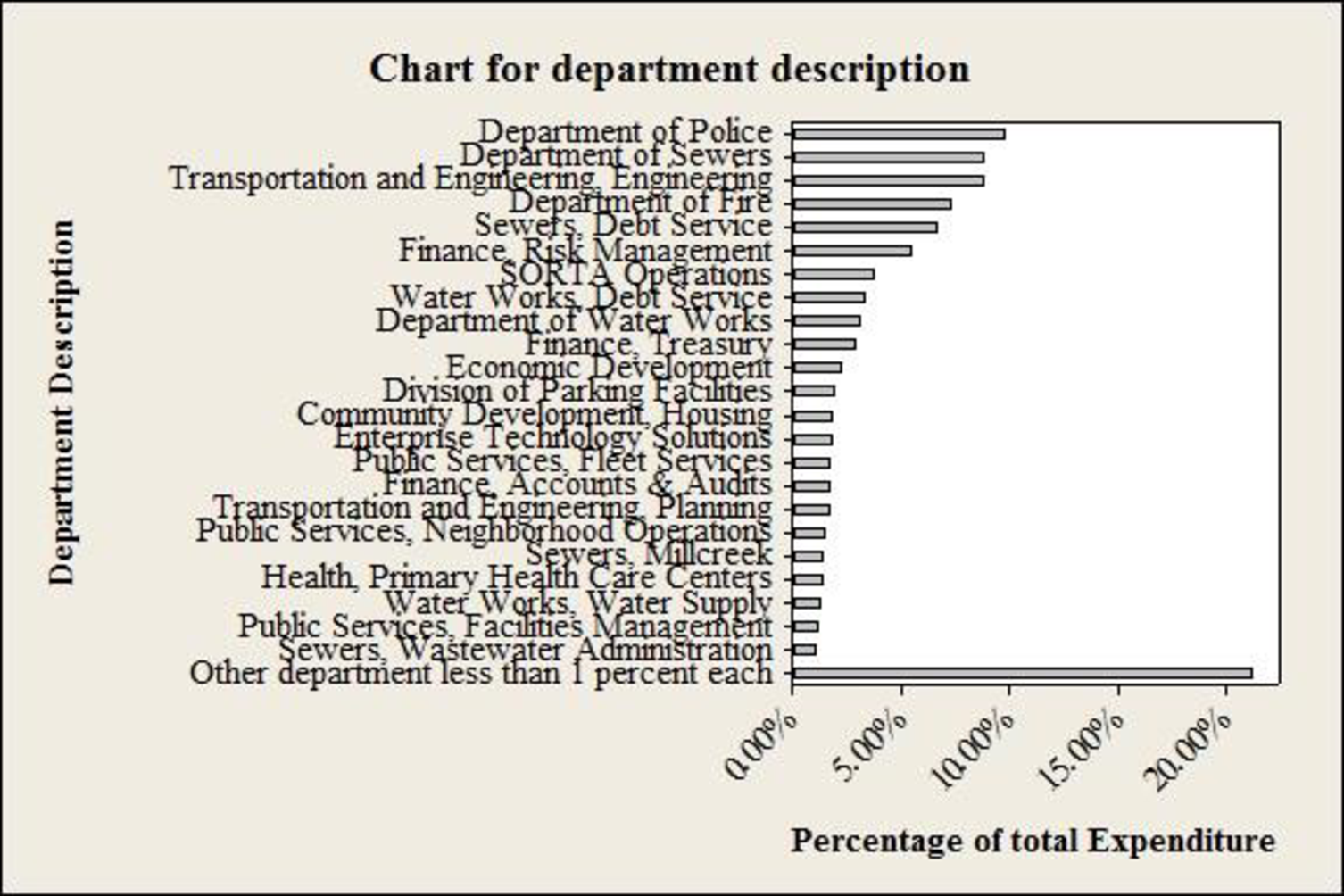
Interpretation:
- From the obtained table and bar chart, it is observed that, 96 departments showing total expenditure as less than 1% over 119 departments.
- There are six individual departments namely police, sewers, transportation Engineering, Fire, sewer debt service and financial/Risk management has total expenditure approximately 5 percent and more.
- Further, other department less than 1 percent each seems to be high, in terms of total expenditure percentage.
c.
Make tabular displays that show the amount of expenditure by fund and percentage of total expenditures by fund and Combine any department with less than 1% into a category named “other”.
Answer to Problem 3CP
The table represents the total amount of expenditure by Fund and percentage of total expenditures by Fund.
| Fund | Total expenditure | percentage of total expenditure |
| 050 - general fund | 16,86,07,659 | 25.5% |
| 980 - capital projects | 10,61,80,470 | 16.0% |
| 701 - metropolitan sewer district of greater cincinnati | 8,37,13,741 | 12.7% |
| 704 - metropolitan sewer district capital improvements | 5,79,54,955 | 8.8% |
| 101 - water works | 5,22,92,202 | 7.9% |
| 711 - risk management | 3,23,80,425 | 4.9% |
| 759 - income tax - transit | 2,42,39,259 | 3.7% |
| 151 - bond retirement - city | 1,55,84,916 | 2.4% |
| 202 - fleet services | 1,09,94,649 | 1.7% |
| 898 - water works improvement 12 | 84,83,304 | 1.3% |
| 897 - water works improvement 11 | 84,34,379 | 1.3% |
| 302 - income tax - infrastructure | 71,02,773 | 1.1% |
| other (less than 1% each) | 8,56,65,960 | 12.9% |
| Grand Total | 66,16,34,693 | 100.0% |
The bar chart for “Fund” is given below:
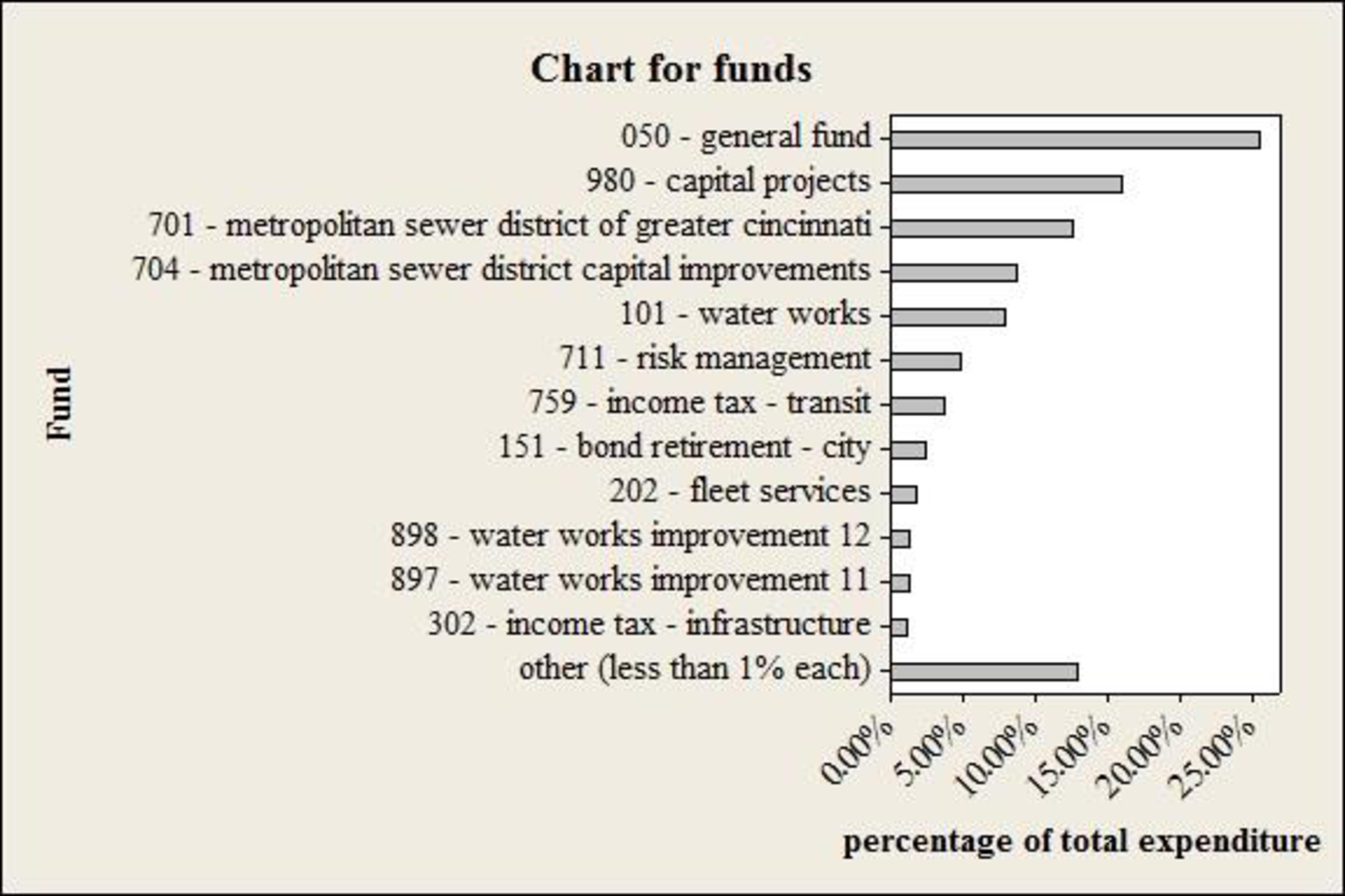
Explanation of Solution
Calculation:
Fund with less than 1% is tabulated as follows with named as “other”:
| Other (Fund less than 1%) | Total Expenditure | Percentage of total expenditure |
| 155 – u square revenue bonds -trustee | 47,48,810 | 0.80% |
| 304 - community development block grant | 46,96,312 | 0.70% |
| 301 - street construction, maintenance and repair | 40,53,506 | 0.70% |
| 103 - duke energy convention center | 35,08,157 | 0.60% |
| 102 - parking system facilities | 33,88,305 | 0.50% |
| 702 - enterprise technology solutions | 32,16,237 | 0.50% |
| 762 - urban redevelopment tax increment equivalent | 28,16,029 | 0.50% |
| 105 - municipal golf activities | 25,96,303 | 0.40% |
| 395 - health services | 24,11,634 | 0.40% |
| 107 - stormwater management | 23,25,888 | 0.40% |
| 368 - law enforcement grant | 22,22,595 | 0.40% |
| 410 - shelter plus care program | 21,62,535 | 0.30% |
| 449 - cincinnati area geographic information system (cagis) | 21,59,283 | 0.30% |
| 353 - home health services | 20,99,548 | 0.30% |
| 457 - clear fund | 19,57,914 | 0.30% |
| 213 - worker''s compensation | 18,17,200 | 0.30% |
| 758 - income tax permanent improvement fund | 17,66,123 | 0.30% |
| 214 - water works stores - chemicals | 15,26,281 | 0.30% |
| 204 - water works stores - materials | 15,06,447 | 0.20% |
| 391 - women and infants food grant program | 14,26,434 | 0.20% |
| 472 - fire grants | 13,62,498 | 0.20% |
| 307 - convention center expansion tax | 12,96,800 | 0.20% |
| 212 - employee safety and risk management | 12,16,265 | 0.20% |
| 491 - municipal public improvement equivalent fund | 12,12,813 | 0.20% |
| 438 - neiborhood stabilization program | 12,11,603 | 0.20% |
| 795 - downtown special inprovement district | 12,02,786 | 0.20% |
| 201 - printing services/ stores | 11,41,805 | 0.20% |
| 306 - municipal motor vehicle license tax | 10,77,283 | 0.20% |
| 323 - recreation special activities | 10,69,119 | 0.20% |
| 411 - home investment trust | 9,91,223 | 0.20% |
| 349 - urban renewal debt retirement | 9,79,853 | 0.10% |
| 350 - public health research | 8,51,919 | 0.10% |
| 418 - federal health program income | 8,48,578 | 0.10% |
| 792 - forestry | 7,40,592 | 0.10% |
| 340 - centennial operations | 7,24,704 | 0.10% |
| 757 - miscellaneous permanent improvement fund | 6,62,729 | 0.10% |
| 104 - lunken airport | 5,86,663 | 0.10% |
| 487 - cuf/heights equivalent fund | 5,62,261 | 0.10% |
| 483 - downtown/otr east equivalent fund | 5,58,694 | 0.10% |
| 156 - fountain square west revenue bonds - trustee | 5,57,577 | 0.10% |
| 412 - food service license fees | 5,50,645 | 0.10% |
| 369 - criminal activity forfeiture - state | 5,23,925 | 0.10% |
| 488 –corryville equivalent fund | 5,19,767 | 0.10% |
| 502 - arra federal grants | 5,09,814 | 0.10% |
| 445 - emergency shelter | 4,53,541 | 0.10% |
| 465 - housing opportunities for persons with aids | 3,73,929 | 0.10% |
| 498 –maidisonvill equivalent fund | 3,63,449 | 0.10% |
| 332 - krohn conservatory | 3,02,862 | 0.10% |
| 364 - 911 cell phone fees | 2,99,652 | 0.00% |
| 381 - cincinnati abatement project | 2,84,022 | 0.00% |
| 317 - urban development - property operations | 2,28,247 | 0.00% |
| 461 - fema grant | 2,19,424 | 0.00% |
| 793 - boulevard light energy and maintenance (blem) | 1,83,378 | 0.00% |
| 324 - recreation federal grant projects | 1,78,387 | 0.00% |
| 166 - graeters revenue bonds - trustee | 1,76,113 | 0.00% |
| 326 - park donations and special activity | 1,71,770 | 0.00% |
| 210 - highway maintenance stores | 1,69,814 | 0.00% |
| 342 - new city buildings operations | 1,67,023 | 0.00% |
| 420 - public employee assistance program | 1,65,141 | 0.00% |
| 446 - health network | 1,64,337 | 0.00% |
| 209 - property management | 1,62,435 | 0.00% |
| 618 - towing charges - private operators | 1,50,000 | 0.00% |
| 314 - special events | 1,46,679 | 0.00% |
| 481 - downtown south/riverfront equivalent fund | 1,44,066 | 0.00% |
| 367 - criminal activity forfeiture - federal | 1,31,116 | 0.00% |
| 753 - expressways/gateways | 1,26,717 | 0.00% |
| 486 - east walnut hills equivalent fund | 1,25,855 | 0.00% |
| 499 - oakley equivalent fund | 1,23,924 | 0.00% |
| 436 - environmental studies | 1,22,482 | 0.00% |
| 318 - sawyer point | 1,15,771 | 0.00% |
| 330 - park lodge/pavilion deposits | 1,02,413 | 0.00% |
| 482 - downtown/otr west equivalent fund | 97,418 | 0.00% |
| 756 - water works capital | 78,225 | 0.00% |
| 485 - walnut hills equivalent fund | 77,402 | 0.00% |
| 207 - recreation stores | 76,091 | 0.00% |
| 161 - msd debt service - trustee - multi series | 71,262 | 0.00% |
| 752 - park board | 69,499 | 0.00% |
| 415 - immunization action plan | 63,781 | 0.00% |
| 478 - justice assistance grant | 56,049 | 0.00% |
| 425 - heart health in hamilton county project | 48,994 | 0.00% |
| 387 - lead hazard control research grant | 48,025 | 0.00% |
| 791 - sidewalks | 45,700 | 0.00% |
| 715 - convention facility authority | 44,830 | 0.00% |
| 454 –metrolpolitain medical response | 42,877 | 0.00% |
| 428 - urban forestry | 41,771 | 0.00% |
| 448 - health care services for the homeless | 41,475 | 0.00% |
| 370 - drug offender fines | 39,325 | 0.00% |
| 363 - solid waste disposal control | 38,714 | 0.00% |
| 490 - evanston equivalent fund | 37,825 | 0.00% |
| 354 - household sewage treatment fees | 35,989 | 0.00% |
| 380 - lead poisoning control | 35,194 | 0.00% |
| 394 - state health program income | 29,632 | 0.00% |
| 413 - swimming pool license fees | 26,801 | 0.00% |
| 476 - uasi grant | 25,094 | 0.00% |
| 405 - market facilities | 24,099 | 0.00% |
| 389 - communications and marketing activities | 22,805 | 0.00% |
| other (less than 1% each) | 85,665,960 | 12.9% |
From the above table, the other category has the total expenditure $85,665,960.
Therefore, the following table shows the amount of all 13 entities total expenditure by Fund.
| Fund | Total expenditure |
| 050 - general fund | 16,86,07,659 |
| 980 - capital projects | 10,61,80,470 |
| 701 - metropolitan sewer district of greater cincinnati | 8,37,13,741 |
| 704 - metropolitan sewer district capital improvements | 5,79,54,955 |
| 101 - water works | 5,22,92,202 |
| 711 - risk management | 3,23,80,425 |
| 759 - income tax - transit | 2,42,39,259 |
| 151 - bond retirement - city | 1,55,84,916 |
| 202 - fleet services | 1,09,94,649 |
| 898 - water works improvement 12 | 84,83,304 |
| 897 - water works improvement 11 | 84,34,379 |
| 302 - income tax - infrastructure | 71,02,773 |
| other (less than 1% each) | 8,56,65,960 |
| Total | 66,16,34,693 |
The percentage for fund is calculated as the ratio of total expenditure to the grand totals all funds.
Therefore, the following table shows the percentage of amount of all fund total expenditure by funds
| Fund | Percentage of total expenditure |
| 050 - general fund | 25.5% |
| 980 - capital projects | 16.0% |
| 701 - metropolitan sewer district of greater cincinnati | 12.7% |
| 704 - metropolitan sewer district capital improvements | 8.8% |
| 101 - water works | 7.9% |
| 711 - risk management | 4.9% |
| 759 - income tax - transit | 3.7% |
| 151 - bond retirement - city | 2.4% |
| 202 - fleet services | 1.7% |
| 898 - water works improvement 12 | 1.3% |
| 897 - water works improvement 11 | 1.3% |
| 302 - income tax - infrastructure | 1.1% |
| other (less than 1% each) | 12.9% |
| Total | 100.0% |
Software procedure:
Step-by-step software procedure to obtain bar chart for category using MINITAB software is as follows:
- From Bars represent, choose Values from a table.
- Under One column of values, choose Simple. Click OK.
- Choose Simple, and then click OK.
- In Graph variables, enter the column of percent frequency for total expenditure in funds.
- In Categorical variables, enter the column of entities of funds.
- Click OK.
Output using the MINITAB software is given below:
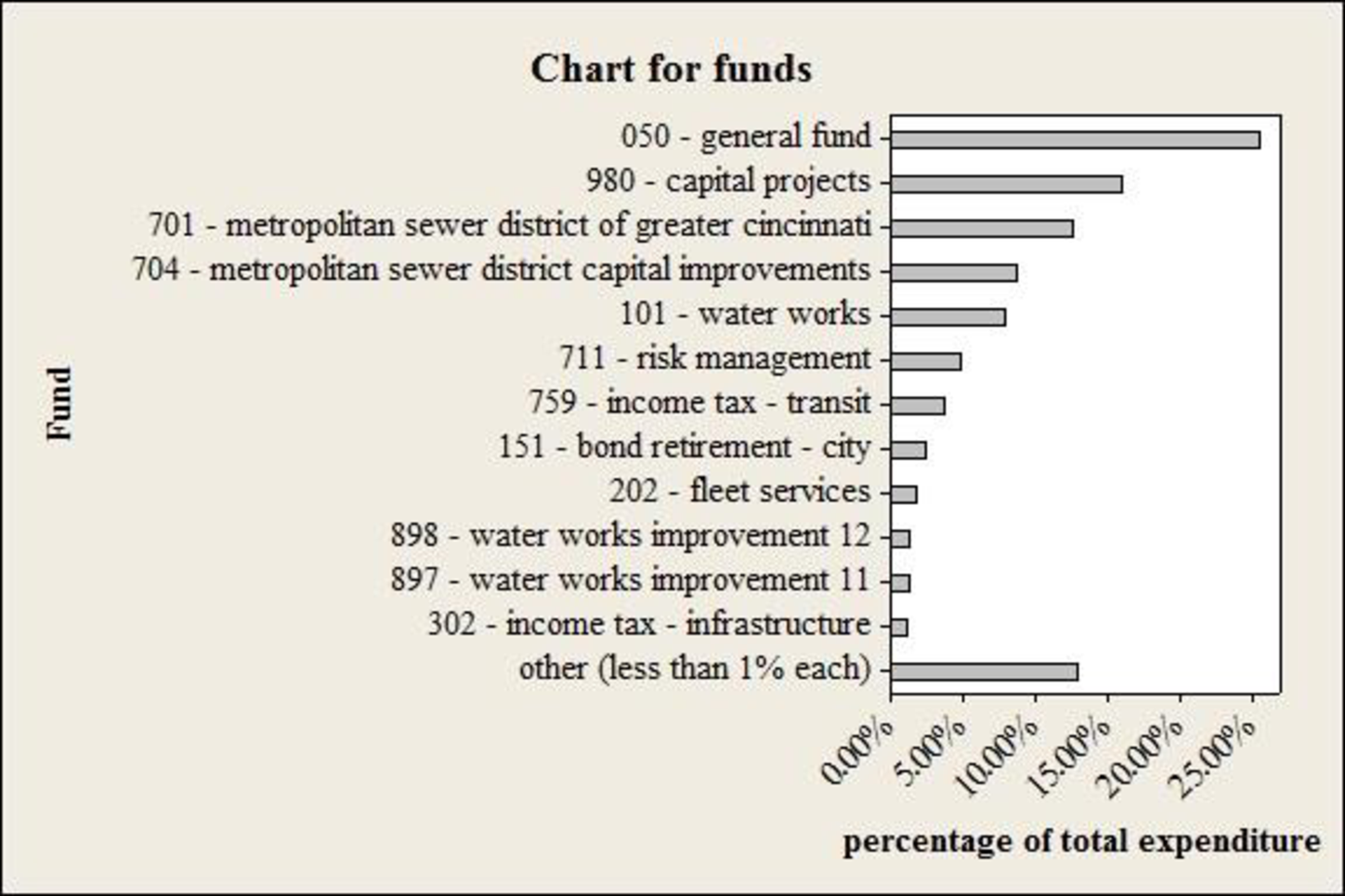
Interpretationn:
- From the obtained table and bar chart, it is observed that, the fund category 050-General fund seems to be high, in terms of total expenditure percentage.
Want to see more full solutions like this?
Chapter 2 Solutions
Bundle: Statistics for Business & Economics, Loose-leaf Version, 13th + MindTap Business Statistics with XLSTAT, 2 terms (12 months) Printed Access Card
- Solve please and thank you!arrow_forward7. In a 2011 article, M. Radelet and G. Pierce reported a logistic prediction equation for the death penalty verdicts in North Carolina. Let Y denote whether a subject convicted of murder received the death penalty (1=yes), for the defendant's race h (h1, black; h = 2, white), victim's race i (i = 1, black; i = 2, white), and number of additional factors j (j = 0, 1, 2). For the model logit[P(Y = 1)] = a + ß₁₂ + By + B²², they reported = -5.26, D â BD = 0, BD = 0.17, BY = 0, BY = 0.91, B = 0, B = 2.02, B = 3.98. (a) Estimate the probability of receiving the death penalty for the group most likely to receive it. [4 pts] (b) If, instead, parameters used constraints 3D = BY = 35 = 0, report the esti- mates. [3 pts] h (c) If, instead, parameters used constraints Σ₁ = Σ₁ BY = Σ; B = 0, report the estimates. [3 pts] Hint the probabilities, odds and odds ratios do not change with constraints.arrow_forwardSolve please and thank you!arrow_forward
- Solve please and thank you!arrow_forwardQuestion 1:We want to evaluate the impact on the monetary economy for a company of two types of strategy (competitive strategy, cooperative strategy) adopted by buyers.Competitive strategy: strategy characterized by firm behavior aimed at obtaining concessions from the buyer.Cooperative strategy: a strategy based on a problem-solving negotiating attitude, with a high level of trust and cooperation.A random sample of 17 buyers took part in a negotiation experiment in which 9 buyers adopted the competitive strategy, and the other 8 the cooperative strategy. The savings obtained for each group of buyers are presented in the pdf that i sent: For this problem, we assume that the samples are random and come from two normal populations of unknown but equal variances.According to the theory, the average saving of buyers adopting a competitive strategy will be lower than that of buyers adopting a cooperative strategy.a) Specify the population identifications and the hypotheses H0 and H1…arrow_forwardYou assume that the annual incomes for certain workers are normal with a mean of $28,500 and a standard deviation of $2,400. What’s the chance that a randomly selected employee makes more than $30,000?What’s the chance that 36 randomly selected employees make more than $30,000, on average?arrow_forward
- What’s the chance that a fair coin comes up heads more than 60 times when you toss it 100 times?arrow_forwardSuppose that you have a normal population of quiz scores with mean 40 and standard deviation 10. Select a random sample of 40. What’s the chance that the mean of the quiz scores won’t exceed 45?Select one individual from the population. What’s the chance that his/her quiz score won’t exceed 45?arrow_forwardSuppose that you take a sample of 100 from a population that contains 45 percent Democrats. What sample size condition do you need to check here (if any)?What’s the standard error of ^P?Compare the standard errors of ^p n=100 for ,n=1000 , n=10,000, and comment.arrow_forward
- Suppose that a class’s test scores have a mean of 80 and standard deviation of 5. You choose 25 students from the class. What’s the chance that the group’s average test score is more than 82?arrow_forwardSuppose that you collect data on 10 products and check their weights. The average should be 10 ounces, but your sample mean is 9 ounces with standard deviation 2 ounces. Find the standard score.What percentile is the standard score found in part a of this question closest to?Suppose that the mean really is 10 ounces. Do you find these results unusual? Use probabilities to explain.arrow_forwardSuppose that you want to sample expensive computer chips, but you can have only n=3 of them. Should you continue the experiment?arrow_forward

 Elementary Geometry for College StudentsGeometryISBN:9781285195698Author:Daniel C. Alexander, Geralyn M. KoeberleinPublisher:Cengage Learning
Elementary Geometry for College StudentsGeometryISBN:9781285195698Author:Daniel C. Alexander, Geralyn M. KoeberleinPublisher:Cengage Learning

